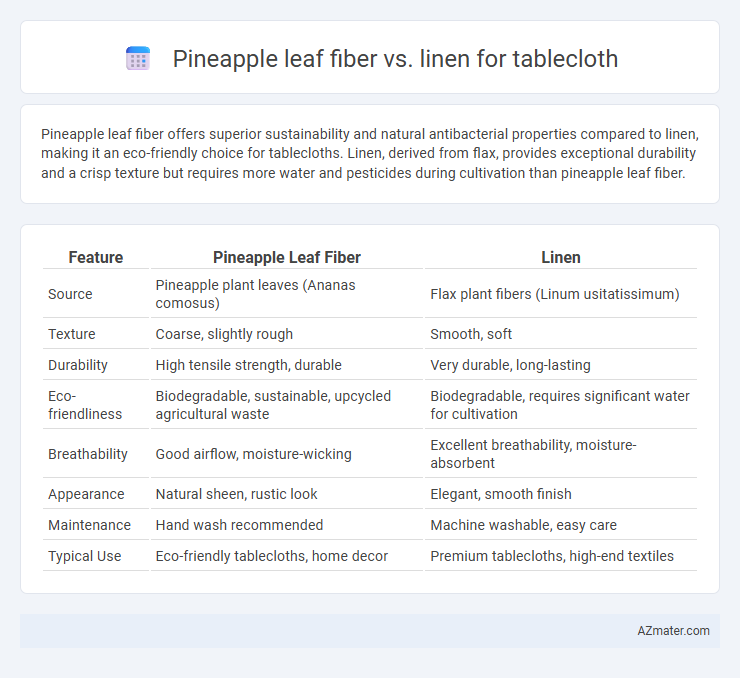Pineapple leaf fiber offers superior sustainability and natural antibacterial properties compared to linen, making it an eco-friendly choice for tablecloths. Linen, derived from flax, provides exceptional durability and a crisp texture but requires more water and pesticides during cultivation than pineapple leaf fiber.
Table of Comparison
| Feature | Pineapple Leaf Fiber | Linen |
|---|---|---|
| Source | Pineapple plant leaves (Ananas comosus) | Flax plant fibers (Linum usitatissimum) |
| Texture | Coarse, slightly rough | Smooth, soft |
| Durability | High tensile strength, durable | Very durable, long-lasting |
| Eco-friendliness | Biodegradable, sustainable, upcycled agricultural waste | Biodegradable, requires significant water for cultivation |
| Breathability | Good airflow, moisture-wicking | Excellent breathability, moisture-absorbent |
| Appearance | Natural sheen, rustic look | Elegant, smooth finish |
| Maintenance | Hand wash recommended | Machine washable, easy care |
| Typical Use | Eco-friendly tablecloths, home decor | Premium tablecloths, high-end textiles |
Introduction to Pineapple Leaf Fiber and Linen
Pineapple leaf fiber, derived from the leaves of the Ananas comosus plant, is a sustainable natural textile known for its strength, durability, and eco-friendly properties, making it an innovative choice for tablecloths. Linen, produced from the flax plant fibers, is a traditional fabric celebrated for its breathability, smooth texture, and natural luster, often preferred for its elegant appearance and moisture-wicking abilities. These two fibers represent unique options for tablecloth materials, combining environmental benefits with distinct tactile qualities.
Origins and Production Processes
Pineapple leaf fiber originates from the leaves of the Ananas comosus plant primarily grown in the Philippines, where fibers are extracted through a decortication process followed by hand scraping and washing to retain their natural strength and shine. Linen, derived from the flax plant cultivated mainly in Europe, undergoes retting, drying, and scutching to separate the fibers, which are then spun into yarn for fabric production. The sustainable extraction methods of pineapple leaf fiber result in a coarse-textured, eco-friendly material, whereas linen production relies on a centuries-old process yielding a smooth, breathable textile favored for its durability and moisture-wicking properties.
Environmental Impact Comparison
Pineapple leaf fiber and linen both offer eco-friendly options for tablecloths, with pineapple leaf fiber emerging as a more sustainable choice due to its use of agricultural waste, reducing deforestation and water consumption. Linen production, derived from flax plants, requires significant water and pesticide inputs, leading to higher environmental impacts. Pineapple leaf fiber's biodegradability and minimal chemical processing further contribute to its lower carbon footprint compared to traditional linen.
Texture and Aesthetic Appeal
Pineapple leaf fiber offers a unique, coarse texture with a natural sheen that enhances the rustic and eco-friendly aesthetic of a tablecloth, providing durability and an organic charm. Linen, known for its smooth, crisp texture and refined appearance, delivers an elegant and timeless look with excellent breathability and a soft hand feel. Both fibers excel in sustainability, but pineapple leaf fiber captures a distinct tropical warmth, while linen emphasizes classic sophistication.
Durability and Longevity
Pineapple leaf fiber exhibits exceptional durability due to its high cellulose content and strong tensile strength, making it resistant to wear and tear in tablecloth applications. Linen, derived from flax fibers, is renowned for its long-lasting quality and natural ability to withstand repeated washing without significant fiber breakdown. Both materials offer impressive longevity, but pineapple leaf fiber provides superior resistance to stretching and fraying, enhancing the lifespan of tablecloths in high-use settings.
Ease of Maintenance and Cleaning
Pineapple leaf fiber tablecloths offer superior durability and stain resistance, making them easier to maintain and clean compared to linen. Linen tends to wrinkle quickly and may require more delicate washing methods, such as hand washing or dry cleaning, to preserve its texture and appearance. Pineapple fiber's natural resilience allows for machine washing and quicker drying, providing a low-maintenance option ideal for everyday use.
Cost and Market Availability
Pineapple leaf fiber offers an affordable and eco-friendly alternative to traditional linen, with cost typically lower due to its renewable agricultural byproduct sourcing. Linen, made from flax plants, often commands higher prices because of its labor-intensive cultivation and processing methods. Market availability favors linen, which remains widely accessible globally, whereas pineapple leaf fiber is emerging and more regionally concentrated, primarily in Southeast Asia.
Hypoallergenic and Health Considerations
Pineapple leaf fiber is naturally hypoallergenic and resistant to dust mites, making it an excellent choice for sensitive skin and allergy sufferers when used in tablecloths. Linen, derived from flax plants, also possesses hypoallergenic properties but may cause irritation in individuals with flax sensitivity due to its coarser fibers. Both materials offer breathable, antimicrobial qualities, but pineapple leaf fiber provides superior moisture-wicking benefits, reducing the risk of bacterial growth and promoting healthier dining environments.
Styling Versatility for Table Settings
Pineapple leaf fiber offers unique textural appeal and natural sheen, enhancing table settings with an eco-friendly, rustic charm that complements both contemporary and traditional decor styles. Linen provides a classic, versatile look with its smooth finish and crisp drape, easily adapting to formal or casual table arrangements. Choosing between these fibers depends on desired ambiance--pineapple leaf fiber suits organic, artisanal themes, while linen excels in timeless, elegant presentations.
Conclusion: Choosing the Best Fabric for Tablecloths
Pineapple leaf fiber offers eco-friendly durability and a natural texture that resists stains better than linen, making it ideal for sustainable and low-maintenance tablecloths. Linen provides a classic elegance with superior breathability and softness but requires more care due to its tendency to wrinkle and stain. For longevity and environmental benefits, pineapple leaf fiber is preferable, while linen suits formal settings seeking traditional aesthetics.

Infographic: Pineapple leaf fiber vs Linen for Tablecloth
 azmater.com
azmater.com